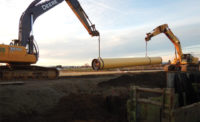The U.S. Environmental Protection Agency is getting ready to open its lending window for $6.5 billion in low-interest loans for a range of water infrastructure projects, including drinking water and wastewater treatment facilities.
EPA announced on June 13 that it will have $5.5 billion available for the fiscal year 2022 round of its Water Infrastructure Finance and Innovation Act (WIFIA) loans plus $1 billion for the similar loans for state water infrastructure finance agency loans (SWIFIA).
The loans are popular because they offer attractive terms and interest rates.
In a new wrinkle, the agency said that for the new lending round it will switch to rolling decisions for the first step in the application process—approving “letters of interest” in WIFIA/SWIFIA loans for particular projects.
In the past, local water agencies would submit letters of interest for WIFIA loans.
Then, typically in just one announcement per year, EPA would “invite” that year's batch of projects to move to the next step in the process, filing final loan applications.
EPA would then close loans for individual projects throughout the year.
In its new funding-availability notice, EPA said that it will start taking letters of interest for the latest round on Sept. 6. The agency then will start working its way through those projects, inviting each that passes muster to submit final applications, until all funds are committed to prospective borrowers.
EPA said in its notice, “A rolling selection process allows EPA to provide year-round access to WIFIA funding and quicker selection decisions to prospective borrowers.”
In addition, the agency said the change is a response to cost inflation and supply-chain problems and also to the major infusion of funding from the Infrastructure Investment and Jobs Act.
Kristina Surfus, National Association of Clean Water Agencies managing director for government affairs, said via email, "The change to the rolling deadline seems positive, and unique among how federal funding and financing programs are administered."
Surfus added, "Communities will have more flexibility to apply when it makes sense for their project, rather than to meet an arbitrary application deadline."
EPA also said it would put a priority on applications for four categories of projects that reflect Biden administration areas of emphasis. They are projects that: involve investment in “economically stressed” areas; focus on replacing lead service drinking-water lines; address perfluoroalkyl (PFAS) and emerging water contaminants; or support water reuse and resilience.
Funds for the 2022 WIFIA/SWIFIA loans come from the 2022 omnibus spending package. That statute, enacted on March 15, provides $58.5 million in direct funding for WIFIA. EPA said that smaller sum would leverage and support about $5.5 billion worth of loans.
When nonfederal funds are added, the agency said, the total value of the projects supported is about $11 billion.
For SWIFIA, the omnibus measure provided $5 million, which EPA said will support about $1 billion in loan volume. Nonfederal funding is estimated at $2 billion.
The final loan applications are due within 365 days of EPA’s invitation to apply.
WIFIA was created in 2014. But due to a shortage of appropriations, EPA did not close any loans from the program until April 2018. EPA has since picked up the pace of loan approvals.
In all, WIFIA has closed 88 loans totaling $15.3 billion.
That includes 31 loans closed In fiscal 2021, with a total value of about $12 billion.




Post a comment to this article
Report Abusive Comment